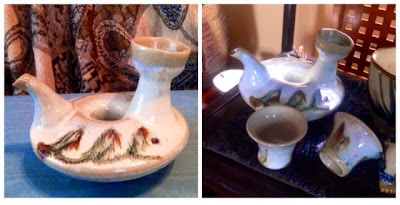Thursday, March 29, 2012
AKAHADA YAKI (赤肌焼き)-Ceramics of Nara Prefecture
| Mark |
| https://akahadayaki.jp/ |
 |
| There are currently 8 generations of Onishi Rakusai |
 |
| Kumidashi tea cups by Niraku Ogawa Kiln 大川二楽 http://www5.kcn.ne.jp/~niraku/ Akahada |
Friday, March 23, 2012
MASHIKO YAKI (益子焼き)-Ceramics of Tochigi Prefecture
http://www.puckergallery.com/pdf/Hamada%203G%202011.pdf
http://www.studio-pots.com/MM1%20ONLINE%20CATALOGUE.PDF
SHIMAOKA TATSUZO (島岡達三) 1919-2007
Living National Treasure (LNT Ningen Kokuho 1996) Mashiko, for his cord-marked ceramics with slip inlay. He apprenticed with Shoji Hamada.
These three cups are unmarked but by every indication are the work of Shimaoka Tatsuzo. Although most of his works are marked with the タ mark, according to an expert in Japanese ceramics (RY) there are pieces, especially those of his earlier years, that are unmarked. These are most likely from the 1960's -1970's.
See:
HAMADA SHINSAKU (second son of Shoji Hamada) 1929~
There was no box with this when I bought it but the style, motif and nuka glaze is classic Shinsaku.
HAMADA MON-GAMA
(Most likely-no box or mark)
MURATA GEN (村田元) 1904-1988
Murata Gen is one of the greatest Mashiko potters. He studied with Hamada Shoji.
HASEGAWA TSUGIO (長谷川つぎお)
 | ||
| Mashiko-yaki tea bowl with Hakeme brushwork with pool of green glaze ************************************ UNMARKED or GENERIC MASHIKO I found this flask in a second hand shop, without a mark, box or identification papers. Interstingly enough I found matching cups in another second hand shop. Because of the color and similar styles in the pottery of Okinawa I originally placed them in that category. I have recently discovered similar "ring" shaped flasks categorized as Mashiko, one with the box with Mashiko written on it. I will now place this flask and matching guinomi in the Mashiko category. It is an unusual shape even for Mashiko. I hope to find out more about this style and will post when I know more. I do know that Mashiko potters, especially Shoji Hamada, did draw influence from Tsuboya yaki, the pottery of Okinawa.
Murasawa Hiroshi Kiln 村澤浩
https://jptca.org/Seto_Hiroshi/?fbclid=IwAR1ggveL-q7oak1hg7pR7a1QYsVpkKpQfQqa18pbKhWMcqMeCGd4-y_WzgE Hiroshi Seto Seto Hiroshi Ceramic artist craftsman Born in Tokushima City, Tokushima Prefecture in 1941. In 1964, graduated from Kyoto City University of Arts, Department of Crafts, Department of Ceramics. Built in 1965 in Mashiko, Tochigi Prefecture. From 1972 to 1973, he was invited to the United States as a lecturer at Indiana University and Colorado State University. Since 1974, he has exhibited in domestic and international solo exhibitions and public exhibitions (invited artists) using striped patterns. He passed away in 1994. ************** ******************
|
Thursday, March 15, 2012
BANKO YAKI (万古焼き)-Ceramics of Mie Prefecture
Bankoyaki is pottery from Mie Prefecture. This is also called Yokkaichi Banko. A pottery merchant, Nunami Rozan, started a kiln near Ise Shrine 1736 and 1741. Annnelise Crueger, in her book "Modern Japanese Ceramics" p. 158, gives a brief but clear history. Rozan was summoned to Edo (Tokyo) to be the potter for the shogun. His work is called Ko-Banko, or old Banko. He had no successor, but years later Mori Yusetsu bought the Banko seal from the family and began a kiln in Mie Prefecture where he created the light tea ware that became popular in the 1800's. Now days it is most famous for brown tea pots and the cookware for nabemono.
The Banko pottery that westerners are more familiar with was produced for export in Tokyo in the late 1800's through the mid 1900's. This Banko, also known as Asakusa Banko, is grouped with Sumida ware, and Poo ware. These are the Banko vases with the 3D carved shrine designs, as well as the "see, hear and speak no evil" monkey figurines.
Banko ware made in Mie Prefecture is also an area that produces manyIkebana vessels.
I have seen a book on Amazon "Fanciful Images: Japanese Banko Ceramics" by Barry Till. I have not read it but thought I would put it out there for those interested in Banko.
 |
| Earthy Banko-yaki kyusuu tea pot |
Banko-yaki makes a lot of everyday ware in Mishima design. The kiln name for this piece is Ginpo.
Banko export ware Made in Japan mark
Vintage Ginpo gama
Seishu Gama 勢州窯 太楽老作
 |
| Right to left 萬古 (Banko) History Links: https://kogeijapan.com/locale/ja_JP/yokkaichibankoyaki/ Contemporary Banko potters link http://bankonosato.jp/wp/exhibition/sakkaten/ |
Subscribe to:
Posts (Atom)
Featured Post
Helpful Vocabulary When Researching Japanese Ceramics
Vocabulary when searching for Japanese Ceramics *I will be adding to this list Dating ( 江戸) Edo Period (1603-1868) (江戸 前期) Ea...
-
From 1921-1941, wares from Japan exported to the United States had to be marked "Japan" or "Made in Japan". During Wor...
-
Kutani ware is from Ishikawa Prefecture. The markings are often in red, but can be impressed, in blue, gold and sometimes black with a g...
-
The This company was in business from 1954-1994. It was bought out by Enesco in 1994. Registered in NYC and San Francisco. Recognized by it...




































